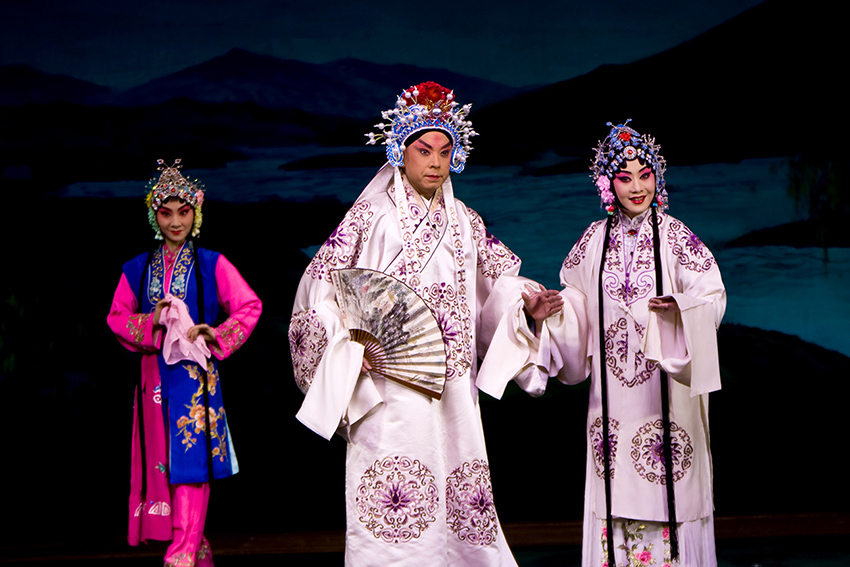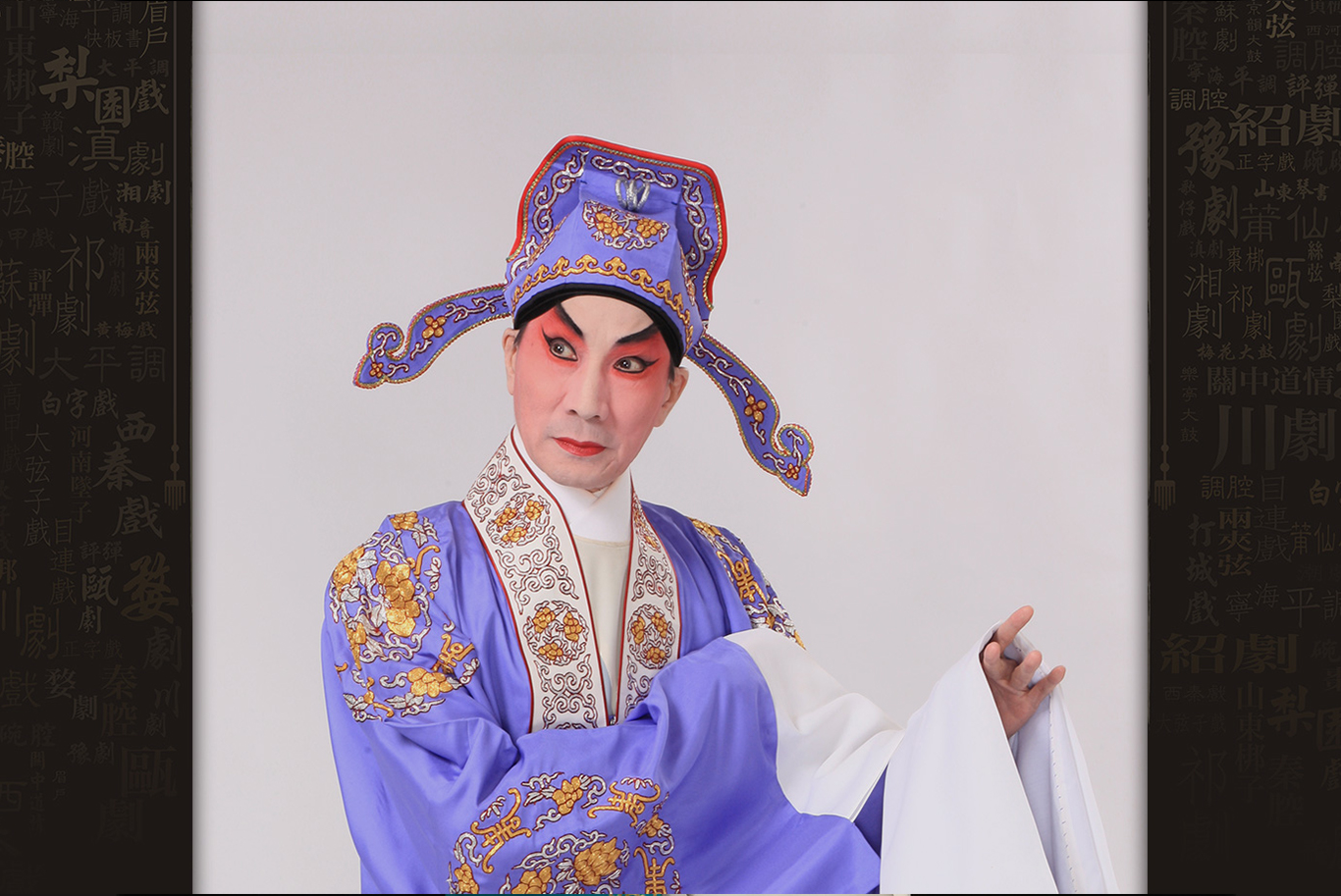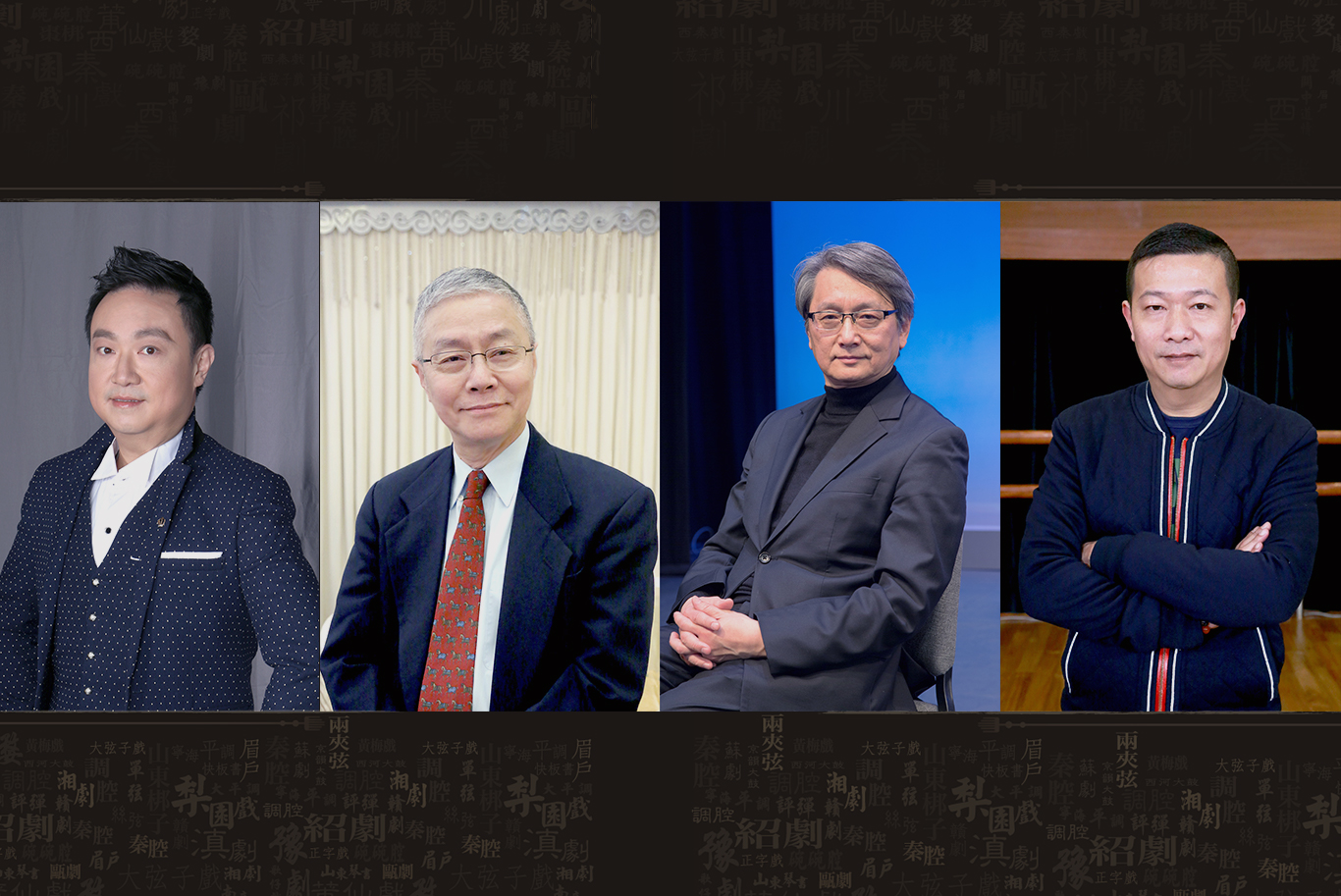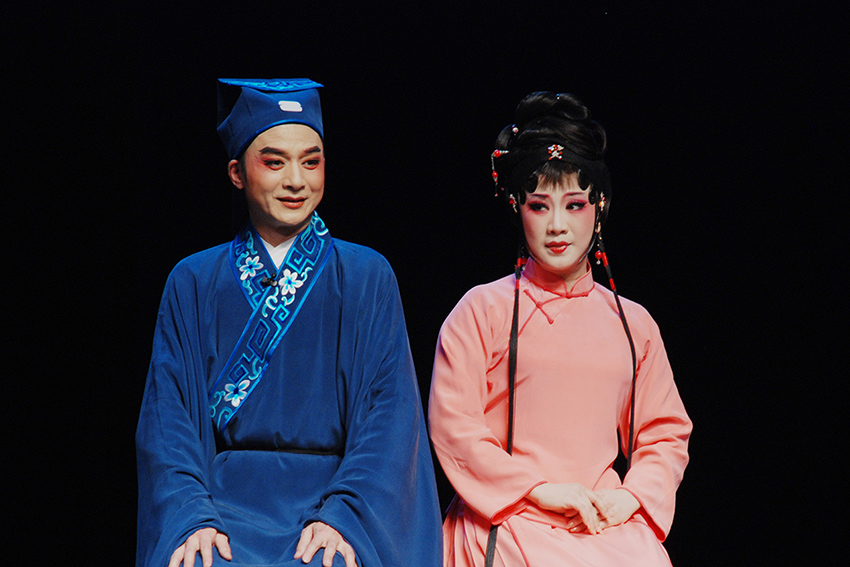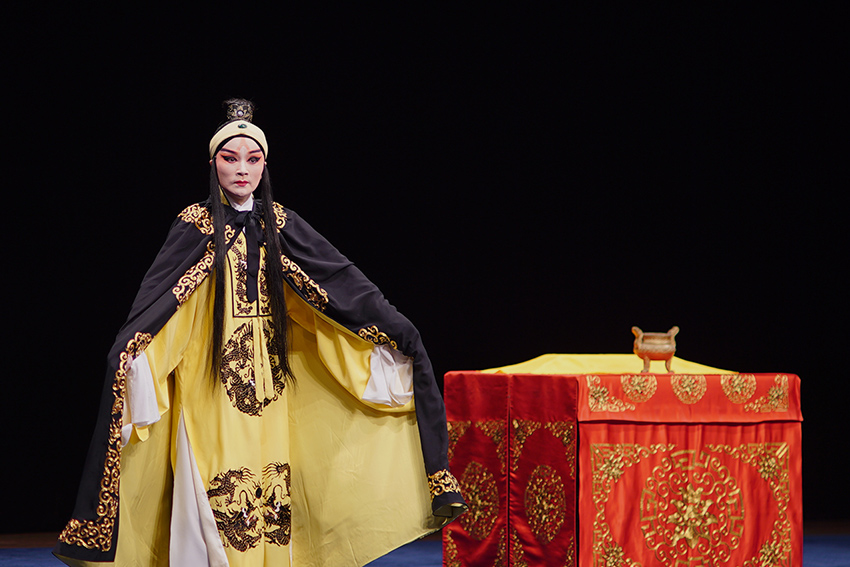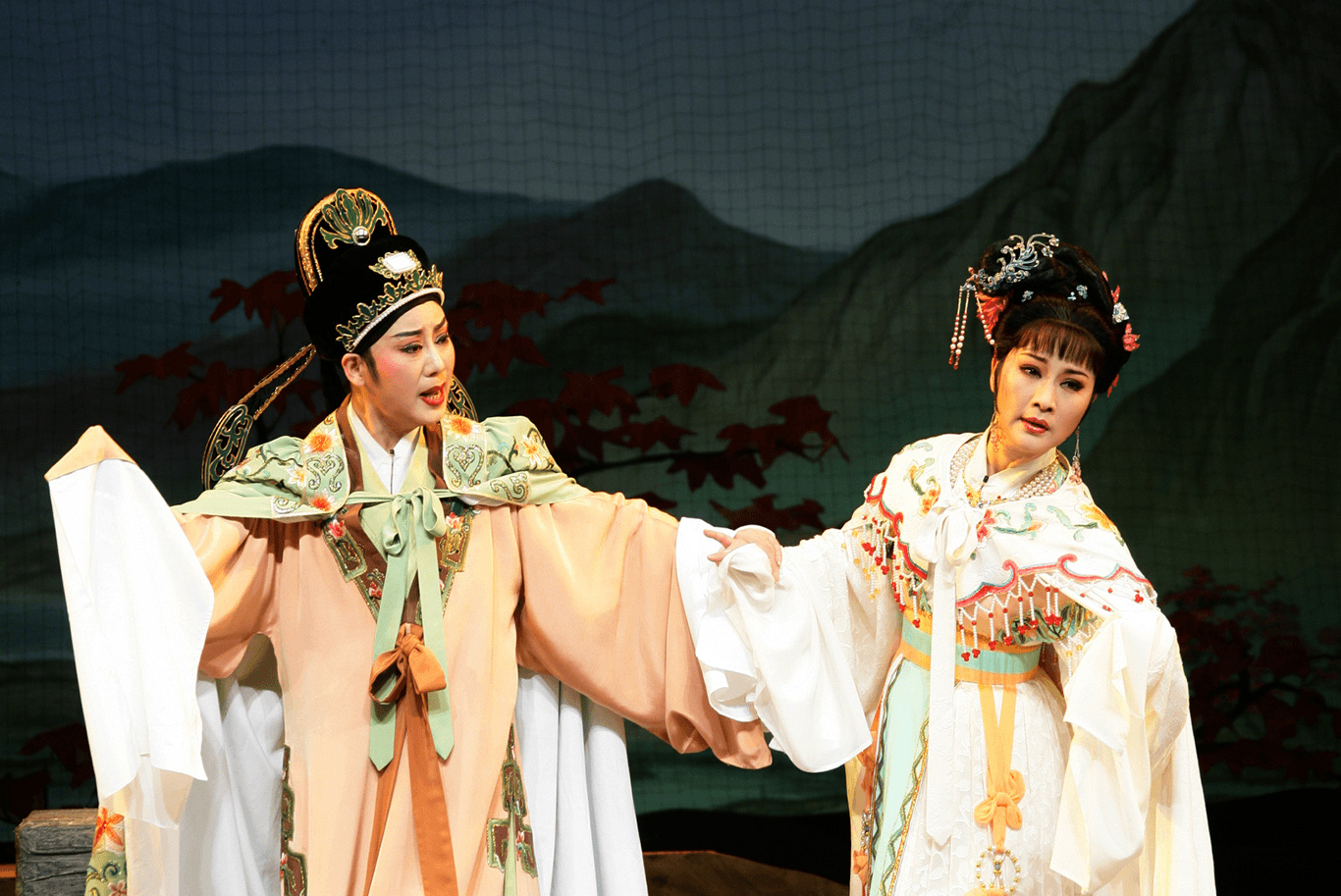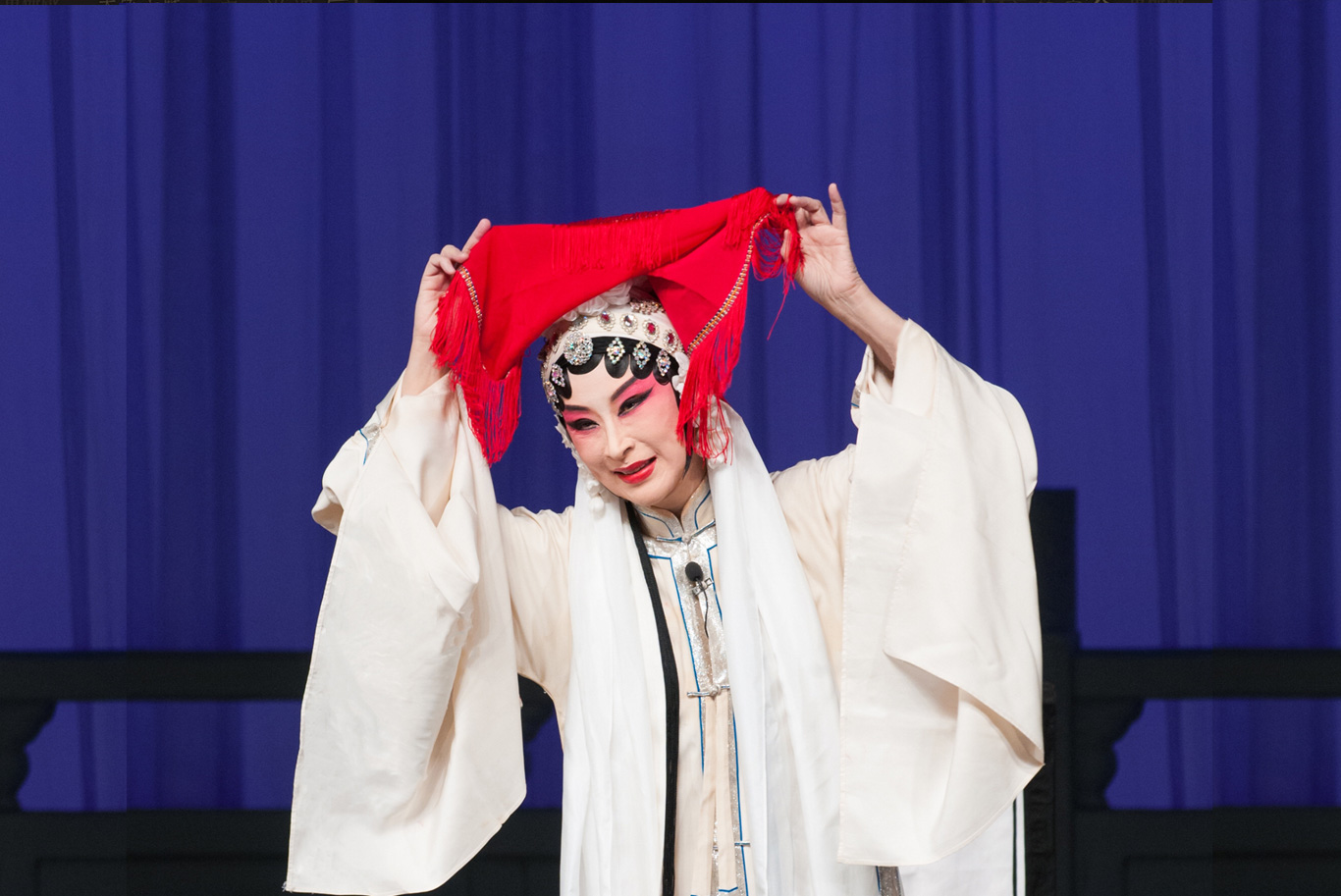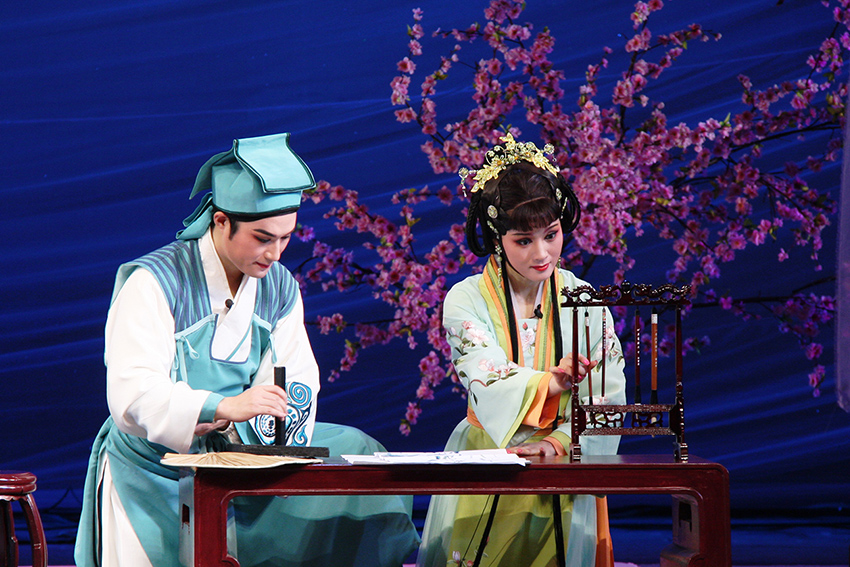‘Living Fossil’ of Southern Opera: Liyuan Opera
Download exhibition content
Liyuan Opera originates in Quanzhou, Fujian and is popular in regions where the Minnan dialect is spoken like Jinjiang, Longxi region, Xiamen and Taiwan province. With a long history of over eight hundred years, Liyuan Opera has been acclaimed as the ‘living fossil of Southern Opera’. In 2006, it has been listed in the first listing of National Intangible Cultural Heritage of China.
Three Main Streams
Liyuan Opera is categorised into three main streams; xiaoliyuan and daliyuan with the latter being further divided into shanglu and xianan. Each of the three streams has its own eighteen pengtou plays and prescribed qupai (set tune). In Southern Song period, Quanzhou’s maritime traffic was well-developed and had a close connection with Wenzhou, Zhejiang. Wenzhou’s zaju (variety drama) was thus spread to Quanzhou. Since the troupe came from northern Fujian, this stream of Opera was named shanglu. The shanglu stream consists of many ancient repertoires and is mostly presented in the ‘remnant extant version’ during performances to relay the overall plot. They usually depict themes on traditional values like loyalty, filial piety, chastity and righteousness while retaining many libretti of Southern Opera. Zhu Maichen is a traditional shanglu repertoire. Having gone through Song, Yuan, Ming and Qing period up to the present, Liyuan Opera can be considered the remnant sound of Southern Opera of Song and Yuan period. No wonder it is known as the ‘living cultural relic’. The xianan stream refers to the Opera developed around the regions of Zhangzhou and Quanzhou. Its repertoires are mostly vernacular works with more dialogues, depicting folktales with a strong sense of everyday life. Singing the Beggar’s Ditty from Li Yaxian is one of the famous repertoires. As for the xiaoliyuan stream, the themes are mostly love stories with focus on the roles of the sheng (male) and dan (female). Classic repertoires include Lu Mengzheng and The Story of the Rabbit, the performances of which are exquisite with refined lyrics and lingering tunes.
Stock Roles
Most of the traditional Liyuan Opera repertoires are civilian plays with no martial arts fighting scene. The plot development is conveyed by singing and speech. There is a uniquely stylised movement routine in its performance known as the ‘Eighteen Steps Basic Directions’. Performers have to follow strict rules like ‘raising hands to the eyebrows, spreading hands to the belly-button, joining hands to the chin’. They sing and dance (not martial arts) as well in a simple and exquisite manner. There are seven role types in xiaoliyuan, also known as qiziban, i.e. seven-member-troupe, namely sheng (male), dan (female), jing (painted face), chou (comic), tie (young female), wai (supplementary) and mo (old male). For daliyuan, two more roles; the laodan (old female, also called laotie) and erdan (female in supporting role) are added.
Vocalisation
The vocalisation in Liyuan Opera belongs to the southern tune with flute and string as the main accompaniment. One word may be sung in varied vocal styles. Performed mainly in Quanzhou dialect, it merges partially with folk music to form a unique Liyuan Opera southern tune vocalisation. Each of the three streams has its characteristic style; shanglu is simple and powerful, xianan is lively and rough while xiaoliyuan is subtle and refined.
Music
In music is composed of qupai medleys which have kept many ancient music pieces extant, some of which date back to as early as the Tong and Song period and are known as daqu’s (full-length tunes) and faqu’s (tunes of Central Asian origin). Its accompaniment consists mainly of flute and string instruments: the dongxiao, the horizontally-held southern pipa, the erxian and sanxian (two-stringed and three-stringed lute) and the aizai (small suona). As for the music of accompanying ensembles, Liyuan Opera uses the aizai and the pinxiao (also called qudi) as the lead, and to accompany the set tunes where tutti is required. Percussion instruments consist mainly of drums, small gong and clappers. When providing accompaniment, the drummer will lift his feet and apply pressure onto the drum with the balls of his feet at different positions, coupled with the beating of drumstick to control the volume and change in tone. Known as the ‘yajiaogu’, this skill is used to heighten the atmosphere and enhance the mood.
Chest-patting Dance
Chest-patting dance is the historical relic of the Minyue tribal dance in Quanzhou region. It is extremely popular in the Quanzhou rural villages bearing special historical cultural value. There are different sayings about its origin. One says it originates from the Liyuan Opera Singing the Beggar’s Ditty from Li Yaxian where the protagonist Zheng Yuanhe wanders in the streets, sings and dances while begging to relieve his feelings. Another saying is it has been in existence for a long time. The painting Treading Joyfully by Song painter Ma Yuan kept in the National Palace Museum has depicted a scene of the chest-patting dance. In it, male dancers wearing grass wreath move along in a squatting position while patting their chest and legs with both hands. They stamp on the ground repeatedly when getting exhilarated while touch the chest, turn over palms, twist and swing when becoming gentle and mellow. Their movements are funny and interesting.
Remnant Extant Version
Since the old Liyuan Opera repertoires are incomplete and fragmentary in scenes and plot, Experimental Theatre of Liyuan Opera of Fujian has conducted rearrangement and restoration on these repertoires and named them ‘remnant extant version’. Based on traditional skills, the theatre follows strictly the oral records of veteran artistes in the rehearsals. Keeping the orally-recorded libretti intact, there is no addition or modification on the extant version during the rearrangement so as to maintain its original form and abide by the rule of ‘restoring the old in its origin form’ in cultural inheritance.
Pengtau Plays
Each of the three streams has its own signature repertoires named pengtau plays. Repertoires depicting the same story may differ in plot development and presentation style.
Daliyuan and Xiaoliyuan
Troupes of the xianan and shanglu streams are both adult troupes, collectively known as daliyuan or referred to as laoxi (adult play). On the other hand, resident troupes of the nobles and aristocracy are called xiaoliyuan or xizi (child play) as they consist of child performers. Xiaoliyuan is not the fruit of daliyuan as the troupe will be dissolved as the child performers grow up.
The Four Indigenous Musical Arts of Guangdong: Where Have All These Genres Gone?
Download exhibition content
Foreword
Quadrangle is a traditional Chinese architectural design, with a courtyard in the middle enclosed by buildings on all four sides, hence the name. The programme this year ‘Guangdong Quadrangle’ is a showcase of four indigenous musical art forms of Guangdong, all filled with characteristics and worthy of preservation, namely Cantonese music, narrative singing, dabayin and Cantonese operatic song in classic singing style. In the long history of Guangdong folk performance art, they are of significant historical and representational value. With the change of times, people become dazzled by the rapidly-changing gadgets and bizarre gimmicks. These treasures are gradually overlooked by the mass or even at the brink of extinction.
Cantonese music nowadays is limited to small-scale performance by small groups which are almost purely for personal interest. Cantonese narrative singing consists of muyu, longzhou, nanyin and banyan. Other than nanyin which has been assimilated into Cantonese Opera, these four styles of narrative singing are facing the crisis of falling into oblivion in Hong Kong and Macao. Dabayin is nearly extinct leaving only a remnant part in Cantonese Opera and in funeral ceremonies. Cantonese operatic song in classic singing style may appear in Cantonese Opera performance from time to time but is incomplete and fragmentary.
The four well-established musical art forms have now become incomplete and fragmentary. We can only try our best to preserve and restore them. The outcome depends on people’s support. With this programme ‘Guangdong Quadrangle’, we hope to arouse people’s awareness, refresh their knowledge and reignite their passion for these four indigenous musical art forms so as to let these treasures to pass on.
Yuen Siu-fai
Artistic Director of
One Table Two Chairs Charitable Foundation Ltd.
Cantonese Music
In its broad sense, Cantonese music refers to the music form that appear in Guangdong province such as Chaozhou silk-string music and Hakka music while in its narrow sense, it refers to the instrumental music that flourishes around the region of Pearl River Delta. This music genre is also known as yueyue. Based on the difference in tone and instrument, it can be divided into ‘taut bow’ and ‘slack bow’. Taut bow ensembles feature high and bright tones, and tend to use instruments such as two-stringed fiddles (erxian and tiqin), plucked lutes (sanxian and yueqin), and bamboo flutes (dizi). Contrasting sharply against taut bow, slack bow ensembles have gentle and delicate tones, and are led by two-stringed fiddles (gaohu, erhu and yehu), hammered dulcimers (yangqin), plucked lutes (qinqin and zhongruan) and end-blown flutes (xiao).
Cantonese music is not only closely related to Hong Kong people, it is also connected to the entire Chinese community. Reference materials reflect that since the last century, Cantonese music has been prosperous in Guangzhou, Hong Kong, Macao, Shanghai, Foshan and Taishan regions. As a matter of fact, Cantonese music not only adheres to tradition, musicians like Lui Man-shing and Wan Chi-chung are very sophisticated. Western instruments such as violin, xylophone, saxophone and guitar have been combined with the playing of Chinese instruments like gaohu, yangqin and dizi. Music instruments of diverse cultural backgrounds are incorporated. Diversity of the East and West matters no more, what matters is the music must be well-played and fun to listen to. Today, Cantonese music has been listed by the China State Council in the first batch of National Intangible Cultural Heritage. Learning and listening to Cantonese music can allow us to reflect upon the formation of local culture.
Narrative Singing
The four types of Guangdong narrative singing: muyu, longzhou, nanyin and banyan actually belong to the same school. Unaccompanied singing with no clapper beat is muyu; it becomes longzhou when sung to the accompaniment of gong and drum, providing rhythm but no beat; becomes nanyin when sung with a clapper beat to the accompaniment of the zheng, and becomes banyan when sung with a faster beat. The singing style of each may differ, yet the structure, line composition and tones are all the same. When and where, and by whom did narrative singing art evolve into the format of today?
Muyu
According to Qu Wengshans’s New Essays of Guangdong wrote during the late Ming and early Qing period, muyu originates from the moyuge of fishermen in the region of Jiangsu province. Due to the difference in dialect, moyu gradually becomes muyu. Muyu refers to the wooden block carved with fish pattern used by Guangdong people in Buddhist chanting. However, there is no need to beat the wooden fish block when singing muyu.
Longzhou
Longzhou were originally folk tunes sung by wandering entertainers as a way to make a living. The entertainers held wooden dragon boats erected on wooden poles as they sang.
Nanyin
The tanban (sandalwood clapper) and zheng used for accompanying nanyin belong to the Jiangnan instrumental music. There is a musical art form with the same name in Fujian, but Fujian nanyin belongs to the nanxi, nanqu and nanci systems, and is considered part of the set tune music family, while local nanyin belongs to the vocal system of banqiang. Nanyin has been very popular in Hong Kong during the beginning of last century, favoured by rich men hanging out in red-light districts. Rich families would also employ blind musicians and female artistes to perform at their homes. Since the 50s, radio broadcast began to gain popularity and nanyin has been one of the most popular programmes. Its lyrics are short and concise depicting mostly love affairs between scholars and prostitutes. Despite the criticism for its unrefined lyrics and disrespect for women, nanyin has commanded a great following and become the pop music of the time. With the rise of Western and Cantonese pop music in the late 60s, nanyin radio programme was officially cancelled. Nanyin gradually disappears from the mainstream local culture. Today, it may sound impossible or impractical to reinstate nanyin into local pop culture, yet the understanding of this singing art help people to appreciate the artistic taste of local people in the old times, relationship between the sexes and the local cultural context. When we think of nanyin singers in Hong Kong, blind musician Dou Wun comes to mind. Dou was blind from childhood and followed the blind musician Suen to learn nanyin. He came to Hong Kong from Macao at the age of sixteen and started singing at opium dens and brothels. He got addicted to opium later on while his wife and son died one after the other. In his twilight years, Dou has sung in the radio station for about 15 years before being dismissed suddenly. He spent his remaining years singing in the street. His life is full of trials and tribulations. Professor Bell Yung has made a recording for Dou Wun on his nanyin, banyan and longzhou singing to let the voice of this remarkable blind musician be heard all over the world.
Banyan
Instead of naming the strong beat as ban and the light beat as ding as is commonly practised in Guangdong, musicians follow the other provinces and name the light beat as yan. One strong and one light beat thus becomes banyan.
It is highly credible that the system of narrative singing art today comes to Guangdong from Jiangsu, Zhejiang and Fujia. Professor Yuen Siu-fai travelled to Shanghai frequently for business during the early 80s and has asked friends in the Ministry of Culture to investigate on this matter. The outcome is affirmative. Yet moyuge which has gone in decline was no longer heard at that time. Since the investigation at that time was not thorough enough, Yuen has decided to continue to investigate. These four types of narrative singing have been in decline in Guangdong. The art has been assimilated into Cantonese Opera performances in Hong Kong and is still performed by certain artists and enthusiasts, though mainly for nanyin. In order not to repeat the same mistake of letting the origin perish, we have to preserve, promote and inherit well this narrative singing art which is filled with folk performance characteristics and has been popular in Guangdong for hundreds of years.
Dabayin
Bayin ensembles flourished around the regions of Pearl River Delta towards the late Qing period and early Republic. Performances can be divided into seated performances and processionals, which were usually held during official government activities, birthday celebrations for folk deities, Taoist rites for fasts and offerings, weddings, and funerals. The core musical instruments are the suona (dida in Cantonese) and various percussion instruments such as the gaobianluo, xiaobo and biangu. In the 4th year of the Xianfeng era in Qing dynasty (1854), Cantonese Opera artiste Lee Man-mau was suppressed for revolting against the Qing court. Cantonese Opera performance was hence banned for ten years. The bayin ensembles at that time used big and small suonas to simulate the voices of the male and female roles to play the opera in its entirety. It became quite popular. In 1935, the Hong Kong Government invited eight bayin ensembles to celebrate King George V's Silver Jubilee. More than 200 people took part in the parade, a testament to the popularity of these ensembles. After the establishment of the People’s Republic of China, bayin has been regarded as feudalistic and performances were banned. Musicians wandered off and the ensembles gradually went into decline.
Guangdong Wind and Percussion Music
Apart from the bayin ensembles in Guangzhou region, Guangdong wind and percussion music also refers to the Shanwei, Zhanjiang, Northern Guangdong, Hakka and Chaozhou music. Each genre has its unique features while also assimilates from the others. For instance, repertoires played by Guangzhou bayin ensembles are mostly kunqiang and gaoqiang set tunes. On the other hand, influence of kunqiang, yiyangqiang and luantan can be seen in the Shanwei music, which is reminiscent of the tune origin of the bayin ensembles. Besides, quite a number of tunes played in these regions have the same titles, for example Wild Geese Landing and Qi-Yan-Hui. They appear not only in Guangzhou bayin ensembles but also in Hakka, Shanwei and Chaozhou music troupes as well. It is estimated that the music of these regions came from the same origin but each developed its unique style due to different language, historical and cultural reasons. Renowned Cantonese Opera musician Ko Yun-hung has pointed out the difference between the southern and northern wind and percussion music is that the former is more powerful and hard, somewhat like the difference between southern and northern kung-fu or lion dance. Exposure to different types of wind and percussion music helps us to understand the formation of local culture.
Speaking of the wind and percussion music closely tied to the lives of Hong Kong people, one cannot fail to mention the funeral music of the Taoist Orthodox Unity Sect played in all funeral parlours every day. In fact, music at weddings and funerals were usually handled by bayin ensembles in the olden days. The first scene in the Hong Kong movie Ah Chiu Getting Married (1958) shows a bayin ensemble parading the streets. The repertoires used for both occasions can be used interchangeably, for example An Ingot of Gold and Xiao-Kai-Men can be used for both weddings and religious rituals. The folk musicians would simply adjust their style of playing to adapt to the occasions and the mood. However, wind and percussion music has become much less important in Hong Kong nowadays. Instead, western string quartet or popular music is usually played during weddings while wind and percussion music is only played to accompany one before being lain into grave.
Luogugui (Gong and Drum Cabinet)
Dabayin was very popular in the last century from the 20s to the 50s. During activities like festival processions, birthday celebrations for deities and Taoist rites of offerings, luogugui (gong and drum cabinet) (gui: insiders pronounce as gwai, meaning ghost) would certainly be seen. Today, this kind of situation can hardly be seen except in festival parades in Peng Chau and villages in Yuen Long. The cabinet used nowadays has been simplified to a big drum wrapped in steel frames. The one and only gong and drum cabinet passed down is kept in the Golden Dragon Museum in Bendigo, a city near Melbourne in Australia. The cabinet shown in this exhibition is a replica of the antique.
Cantonese Operatic Song in Classic Singing Style
Guangdong, located more to the south of China, did not have its own style of traditional theatrical forms. The ones that were performed on stage came from other provinces and were not sung in Cantonese. To trace the origin, we have to start with Cantonese operatic songs in classic singing style.
Classic Style, Contemporary Style
How to define ‘classic’ and ‘contemporary’ singing style? The term ‘Classic singing style’ may not have existed a hundred years ago. It is probably our predecessors in the early Republic that proposed Cantonese Opera should be sung in Cantonese. Through the modification and refinement by various predecessors like Kam Shan-bing, Pak Kui-wing, Tai Chi-cheuk and Chu Chi-pak, Cantonese operatic singing has evolved into the format of today. Despite it is sung in Cantonese, the ancient repertoires and classic singing styles are still valuable and have not yet disappeared entirely.
The distinct difference between ‘classic’ and ‘contemporary’ singing style is that ‘classic’ singing style was performed in guanhua or Zhongzhouyun, also known as Zhongyuan yinyun. There is also a saying that guanhua came from Guangxi Guilin, known as ‘Guilin guanhua’. Guanhua refers to the dialect spoken by officials or the dialect used to converse with officials. At that time, most officials would be transferred elsewhere to minimise corruption and avoid the possibility of nepotism. Most officials in Guangdong thus came from other provinces. As it was not possible to use Cantonese to converse with them, guanhua was used as a result. The other saying on Guangxi Guilin pointed out that the founder was maestro Zhang Wu from Hubei. He went to Beijing to perform after gaining popularity but was wanted by the government for anti-Qing propaganda, fled south to Foshan Dajiwei in Guangdong.
Bangziqiang, Erhuangqiang
The banqiang musical structure of Chinese opera is divided into two major systems: bangzi (or bangziqiang) and erhuang (or erhuangqiang). Together, these two systems form the classic singing styles. The same musical mode tends to be used for its beat forms, from shouban to shaban, no matter it is in bangziqiang or erhuangqiang. Acquaintance with Cantonese operatic singing in classic singing style means acquaintance with the systems of bangzi and erhuang.
There is a consistency to the bangzi and erhuang singing styles, which are basically made up of a couplet, with a first line (the last word rhyming with tilting tones) and a second line (the last word rhyming with level tones). The performance may appear boring to the audience but actors can give their own spin to the classic singing style using different vocal techniques and approaches to highlight the character’s personality. For instance a line of the same beat sung by military characters Lu Bu, Zhou Yu and Zhao Yun may sound very different. Likewise for xiaosheng (young male) roles such as Jia Baoyu and Zhang Junrui, the same tune pattern can be sung and interpreted differently. To study and search for different ways and styles of singing while in the meantime appreciate the origin of the art of operatic singing.
Writer (Chinese): Yuen Siu-fai (Adjunct Associate Professor of Department of Music at The Chinese University of Hong Kong)
English translation: Jeanie Wong and KCL Language Consultancy Ltd.
Photos: Bell Yung (Emeritus Professor of Music at the University of Pittsburgh, Affiliate Professor of Music at the University of Washington), The Centre for Chinese Music Studies of the Chinese University of Hong Kong and Yuen Siu-fai
Acknowledgement: The Centre for Chinese Music Studies of the Chinese University of Hong Kong
Fine Combination of Civil and Military Highlights: Ou Opera
Download exhibition content
Ou Opera
Officially renamed as ‘Ou Opera’ (which ‘Ou’ refers to ‘Wenzhou’) in 1959 from the previous genre name of ‘Wenzhou Luantan’, this regional theatre genre is popular in Wenzhou in southern Zhejiang. It was inscribed onto the second National List of Intangible Cultural Heritage in 2008. The music of Ou opera is mainly luantan; in performance, it has already established a style that is simple, fast-paced, robust yet insightful. It embraces both civil and military repertories, with equal emphasis on singing and acting. The military plays assimilate local martial arts and fighting routines into breathtaking stunts. The spoken lines are delivered in a mixed vernacular that blends the Wenzhou dialect with Zhongzhou (Central Plains) tonal inflexions. Its music has a high-flung, flowing quality that can externalise the complex emotions of the characters.
The Formative and Development Stages of Ou Opera
The inchoate form of Ou Opera appeared during the transition years of the Ming and the Qing periods in the 17th century. The life of peasants was monotonous and tedious, and watching theatre shows became their main source of entertainment. In addition, everywhere shamanistic nuo worship thrived, and people in rural areas used nuo dance, nuo plays and other sacrificial rites to pray for peace and to exorcise spirits that were believed to bring on plaques. Such emphasis on sacrificial rites soon led to staged theatre. That is why there is the saying that Ou Opera originated from folk religion.
With the increase of ritual activities and the introduction of various kinds of vocal types to Wenzhou, semi-professional theatre troupes giving thanksgiving performances for the gods emerged. The number grew when the trend became popular in the rural areas, so much so that they could afford to turn professional. They were hired to give performances for both celebratory occasions and funerals in the villages. A vernacular genre called ‘Wenzhou Luantan’ began to take shape. By assimilating the vocal styles of other genres, it soon came into its own.
In the mid-19th century, with the rapid development of commerce and handicraft trades in Wenzhou, Wenzhou Luantan boomed. Many troupes were formed and took in trainees. It began to spread throughout Zhejiang Province, and even to Taiwan and other places. But by the early 20th century, Peking Opera had come to Wenzhou and begun to replace it in terms of popularity. Most of the luantan troupes and associations were dispersed, and the genre went into a downturn. It was not until the 1950s when three famous luantan troupes merged and staged productions featuring the traditional repertory that it caught the public attention again. Wenzhou Luantan was renamed ‘Ou Opera’, a genre distinguished by an exquisite and unique performing style.
Musical Features
The vocal style of Ou Opera combines the tonal features of gaoqiang, kunqiang, huidiao, pihuang, tanhuang and shidiao, with singing basically adopting luantan in the main and other vocal styles occasionally. Simple but bright in tonal qualities, its rustic touch is balanced by the insightful interpretations. Since Wenzhou is the birthplace of nanxi (Southern Opera) in the Song and Yuan period, and Ou Opera also originated in Wenzhou, Ou Opera retains a lot of the features of nanxi and this adds to the value of the genre. Of the ‘Four Main Vocal Styles’ that were derived from nanxi, only gaoqiang and kunqiang are retained to this day and are sung in Ou Operas still.
The gaoqiang vocal style in Ou Opera is distinguished by one unique feature, which is ‘one voice in the lead, the others sing as chorus’. Only the percussion ensemble provides the beat, and the music has no wind or string instruments involved. But in the kunqiang vocal style, pitches are determined by the word or syllable. The accompaniment includes the Chinese flutes (dizi and xiao) and the lute, pipa, allowing for fluidity in the musical flow. The set tunes in Ou Opera include the zhengluantan which has brilliant tones and a metallic ring suggesting strength; the fanluantan which is gentle, soft and almost beseeching in tone; and erhuan which is sonorous and high-pitched, which can invite people to sing out like a clarion call, and can trigger strong emotions in the actor as well as the audience.
Role Types
In its inchoate stage, Ou Opera only consisted of eight role types – the ‘upper four roles’ of sheng (male), dan (female), jing (painted face) and chou (comic), and the ‘lesser four roles’ of wai (supporting old male), tie (young girl), fu (high-status but crafty person) and mo (supporting). As the genre developed, more role types were needed and the categories grew into nineteen, known as ‘three tang and sixteen jiao’.
Special Features in Ou Opera Performance
Ou Opera emphasises both singing and acting in performance, in particular the delicate facial expressions and stylised movements. Its martial art repertory assimilates Chinese boxing and martial arts skills, and the actors are adept in close combat and fist fighting, demonstrating fast moves that are choreographed to thrill and to excite. In addition, the use of weapons such as the three-section cudgel, meihua gun (plum blossom stick used by the Shaolin Kun Fu school), pitchfork, fan and arrows can add animated interest to a scene. All actors in Ou Opera are trained in their stylised movements respective to their role type, such as the ‘sparrow’s steps’ (crossed steps) of the actor in xiaosheng roles; the ‘inching step’ and ‘falling step’ of the dan role; the stunts of the xiaohualian (half-painted face) such as tossing the gong, the hat trick and the fan trick; and the act of ‘carrying the corpse’ by the qingyi (virtuous female) role.
In addition to stunts in stylised movements, unique mask-painting is also a distinguished feature of Ou Opera. By sheer use of colour and pattern, it allows the audience to immediately associate the mask with the persona. The ‘painted face’, therefore, has highly symbolic meanings, and the Ou Opera troupes and actors attach great importance to face painting.
There is a saying regarding the ‘painted face’ spectrum in Ou Opera, namely ‘six white, seven red and eight black’. White depicts a sinister persona with devious personality – Cao Cao and Dong Zhuo are included in the ‘six white’. Red represents the loyal and courageous - the ‘seven red’ includes Guan Yu, Jiang Wei, etc. Black represents the brave but reckless - the ‘eight black’ includes King Chu (Xiang Yu), Jiao Zan, etc. There are also gold-and-silver masks to depict gods, immortals and monsters, such as the God Erlang, Buddha, the ‘Leopard’ etc. Other than the differentiation by colour, there is in addition a large variety of mask paintings, such as the ‘slanted face’, ‘yin-yang face’, ‘animal face’, ‘speckled face’, ‘texts on face’, etc. The highly imaginative design and use of colour, together with the characters' costumes and use of props, create a vivid and recognisable system in Ou Opera.
Ou Opera Classic Gao Ji and Wu Sanchun
Gao Ji and Wu Sanchun was premiered in 1956. The original version was adapted from a folk tale popularly found in southern Zhejiang by Wenzhou playwright He Qiongwei. Starring 26-year-old Chen Chahua at that time it had a highly successful run for 21 shows at the Southeast Theatre. It was such a box office draw that there was a saying that ‘Thousands of people turned out to see Chahua’. The production laid a very good foundation for a revival of Ou Opera on the theatre stage, and even rewrote the fate and future of the regional genre.
For the present newly revamped production, it features Yang Xiaoqing as director, and Plum Blossom Award winner Fang Rujiang and White Magnolia Award winner Cai Xiaoqiu in the lead. The production has been trimmed from the original duration of three hours to about two hours. The main plot is retained, while the development of the storyline is sped up, thus achieving a new breakthrough in this classic work.
The climax of the play is the episode On Peach Blossom Range. With his heart torn between anger at Sanchun’s betrayal and his love for her, Gao Ji walks up the mountain. The complex emotions in his heart are externalised as he picks his way up the slope, crosses the stream, and trips over pebbles. When he finally discovers that Sanchun has made that sacrifice out of her concern for him, Gao Ji bursts into action to try to catch up with the bridal sedan chair. The actor needs to show the emotional upheaval of the protagonist in an excerpt of a mere 20 minutes, with the requisite skills of singing, delivery of lines, acting and dance all played out in one go.








